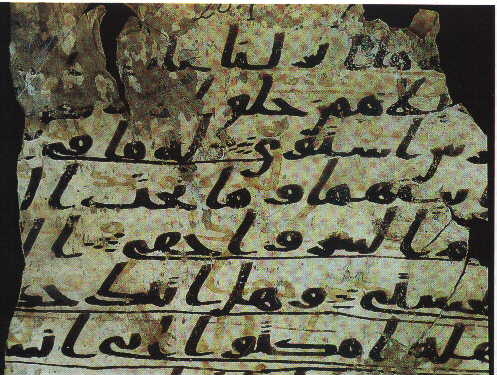A Qur'an Palimpsest from the Sanaa Qur'ans
One of the big formate
Hijazi Qur'ans, found in the Great Mosque in Sanaa, is a palimpsest from early
8th century. Here is a picture of one of its sheets:

Palimpsest of Codex Sanaa 01-27.1,
Dâr al-MakhTűTât al-Yamanîya, Sanaa,
(Photo: Gerd-Ruediger Puin; 1)
This codex is one of the
Qur'an fragments/specimens which were found in 1972 in the loft of the Great
Mosque in Sanaa, Yemen. These Yemeni Qur'ans were an object of scholarly
research from 1980 onwards. Under the supervision of Dr. Albrecht Noth,
Professor at the University of Hamburg, Dr. Gerd-Ruediger Puin was in charge of
the scholarly as well as practical organization of the project from 1981 until
1985, when he was succeeded by his colleague Dr. Hans-Caspar Graf von Bothmer
for another two years (2).
The above piece of the
palimpsest codex shows two layers of script. Both scripts are of the Hijazi
type:
Firstly, a dark brown
script is part of surah 20:1-10 (surah Taahaa or al-kamiyl).
Secondly, with some
patience you will realize that under the darkbrown script traces of a light
brown script are recognizable. This latter original script was washed off from
the parchment so that it might be used again. The chess-boardlike pattern of
the substrate is an artifact of the scanning procedure.
Without applying special
technical means the older script is not readable, but it is undoubtedly a
Qur'anic text, too. This is to be seen easily by a peculiarity of both
layers of writing: The washed off script as well as the second writing display verse
separators, i.e. some simple geometrical point patterns. Even in the above
small piece of the palimpsest one may recognize such separators in both layers
of writing. Additionally at least one separator of surahs (two
parallel lines crossing the page from right to left, again with some patterns
between them) clearly can be recognized in the original script of the
palimpsest codex (to be seen in the above piece). Such separators were used only
in Qur’ans. There seems to be not any exception in non-Qur’anic texts
within other early-Islamic writings.
Why the older layer was
wiped out cannot be said definitely untill it can be read in detail. But there
is hardly any other explanation for this replacement of a Qur'anic text by
another one conceivable than that the older text version might have scandalized
theologians or other people in power or charge. This doesn't necessarily imply
an alteration of the very text, since the formative period of the Qur'anic text
already may have been completed, when the first script was written. Most probably
the arrangement of the surahs was altered. And this hypothesis is corroborated
by the fact that amongst the findings in Sanaa there are indeed Qur'ans with an
arrangement of surahs different from the transmitted
Qur'an.
Notes:
1. Hans-Caspar Graf von Bothmer, Karl-Heinz Ohlig, Gerd-Ruediger Puin: "Neue Wege der Koranforschung". magazin forschung (Universitaet des Saarlandes, Saarbruecken) 1/1999, p. 33-46; courtesy of Dr. Gerd-Ruediger Puin.
2. Gerd-Ruediger Puin: "Observations on Early Qur'an Manuscripts in
San'a'". - Stefan Wild (ed.), The Qur'an As Text, Leiden/New York/Koeln
(E. J. Brill) 1996, p. 107-111
![]()
Back to homepage
| Islamic Matters | Textual Criticism of the Koran